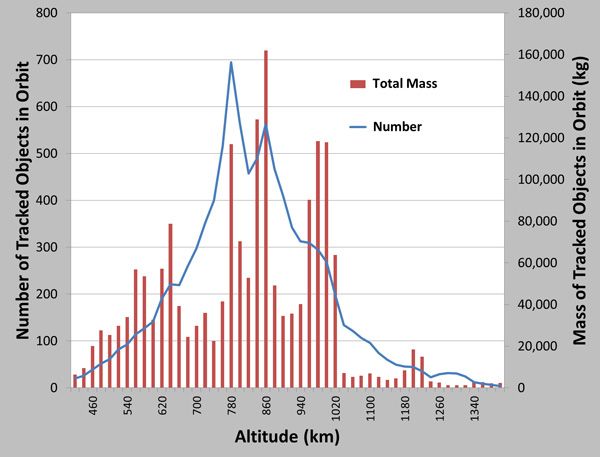
We’ve Already Passed the Tipping Point for Orbital Debris
Re: We’ve Already Passed the Tipping Point for Orbital Debri
This is why unprotected TPS systems such as those found on lifting bodies and winged vehicles are not a good idea for future crewed vehicles.
The capsule designs can shield the most critical portions of their TPS with their service modules but an equivalent shield would be very expensive for a Dream Chaser and nigh on impossible for a Skylon.
If the Kessler Syndrome occurs there will be more vehicle subsystems needing protection, not just the TPS.
This problem is an opportunity for risk-taking private space entrepreneurs. Imagine a slew of private companies going after space junk.
Governments and/or space insurance consortiums would, however, have to pay sizable awards for the recovered items to make the effort worthwhile. Some recovered items would be quite valuable to collectors and museums even without such help (e.g., the Vanguard satellite, now the oldest in orbit).
Then there's the classified stuff...
If Commercial Space really takes off, the need for orbital cleanup will increase in parallel.
Governments and/or space insurance consortiums would, however, have to pay sizable awards for the recovered items to make the effort worthwhile. Some recovered items would be quite valuable to collectors and museums even without such help (e.g., the Vanguard satellite, now the oldest in orbit).
Then there's the classified stuff...
If Commercial Space really takes off, the need for orbital cleanup will increase in parallel.
Last edited by DeltaV on Fri Sep 28, 2012 4:16 pm, edited 1 time in total.
Please also do not forget that part of the "increase" in orbital objects corresponds to our improving ability to see them.
And that is not talking about the classified stuff, SSN or in flight...
And that is not talking about the classified stuff, SSN or in flight...
The development of atomic power, though it could confer unimaginable blessings on mankind, is something that is dreaded by the owners of coal mines and oil wells. (Hazlitt)
What I want to do is to look up C. . . . I call him the Forgotten Man. (Sumner)
What I want to do is to look up C. . . . I call him the Forgotten Man. (Sumner)
that is what I thought. LEO is fine but most sats are further out to cover more area.DeltaV wrote:Long wait.kurt9 wrote:Most of this stuff is in decaying orbits. Just wait for it to come down over time.
[imag]http://www.nap.edu/books/0309051258/xht ... g00006.jpg[/img]
[imag]http://ccar.colorado.edu/asen5050/proje ... s_time.png[/img]
One could argue that. But at the same time, one could also argue that if all that unseen crap was flying around so far without hitting stuff, maybe it isn't as bad as thought.DeltaV wrote:So the problem is worse than thought, since a lot of stuff was/is being missed.ladajo wrote:Please also do not forget that part of the "increase" in orbital objects corresponds to our improving ability to see them.
I personally think that the best part is that when there is a failure, for the most part, they really don't know why.
The development of atomic power, though it could confer unimaginable blessings on mankind, is something that is dreaded by the owners of coal mines and oil wells. (Hazlitt)
What I want to do is to look up C. . . . I call him the Forgotten Man. (Sumner)
What I want to do is to look up C. . . . I call him the Forgotten Man. (Sumner)
Instead of just complaining, how would a mess of orbital debris be cleaned up?
Big pieces could be picked up or kicked into disposal orbits if we had cheap enough space flight.
How much debris is conductive, and would experience drag flying through a magnetic field? Would a satellite generating a strong magnetic field around itself do any good?
How much is small debris that could pick up an electric charge if a field was established between different orbital levels?
Big pieces could be picked up or kicked into disposal orbits if we had cheap enough space flight.
How much debris is conductive, and would experience drag flying through a magnetic field? Would a satellite generating a strong magnetic field around itself do any good?
How much is small debris that could pick up an electric charge if a field was established between different orbital levels?
-
kunkmiester
- Posts: 892
- Joined: Thu Mar 12, 2009 3:51 pm
- Contact:
-
paperburn1
- Posts: 2494
- Joined: Fri Jun 19, 2009 5:53 am
- Location: Third rock from the sun.
small space base laser to burn the front of anything passing to push it into a lower orbit. within or capability's now but I suspect it could also be a mighty handy weapon for blinding Sat's and therefore be hated by every space faring nation that does not have one of their own.hanelyp wrote:Instead of just complaining, how would a mess of orbital debris be cleaned up?
Big pieces could be picked up or kicked into disposal orbits if we had cheap enough space flight.
How much debris is conductive, and would experience drag flying through a magnetic field? Would a satellite generating a strong magnetic field around itself do any good?
How much is small debris that could pick up an electric charge if a field was established between different orbital levels?

